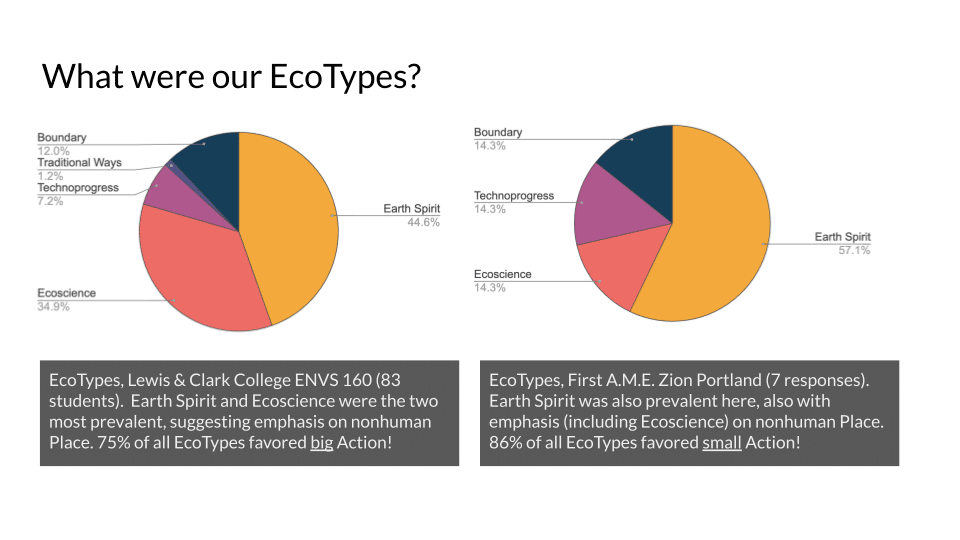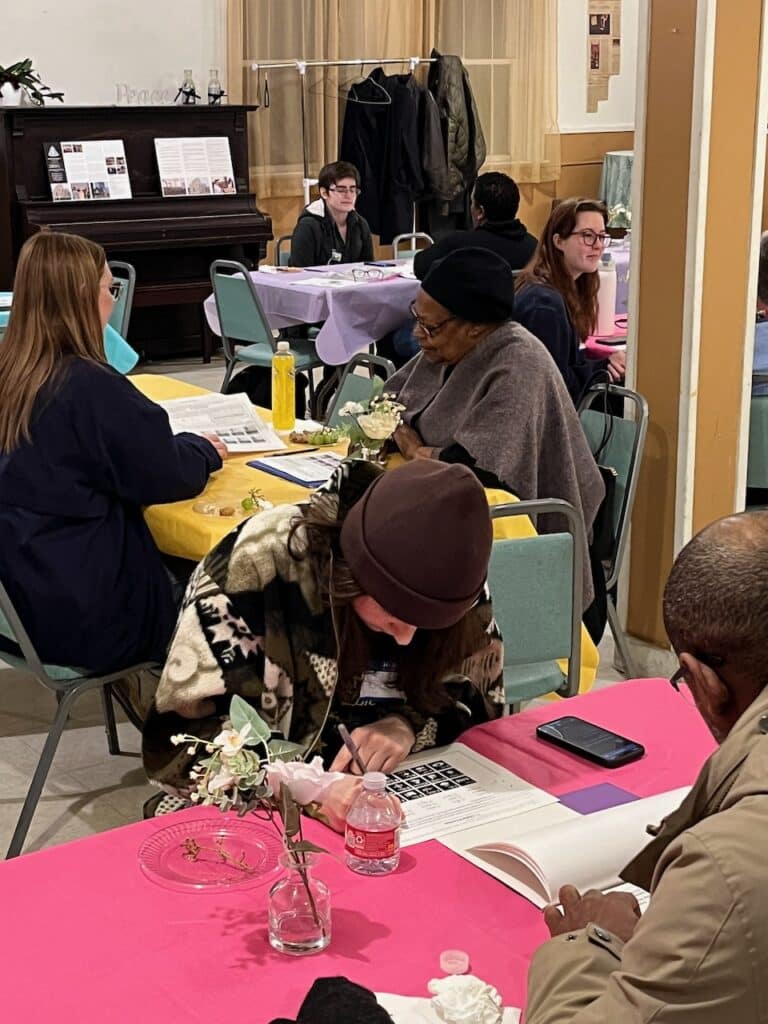BACKGROUND | COMPARISON | CONCLUSION | SP24 UPDATE
Background

In fall 2023, students from Lewis & Clark College interacted with members of the First A.M.E. Zion congregation in Portland, Oregon to explore the EcoTypes possibility that “many care, just differently” in the context of a Black community of faith. We expected differences relative to our largely white, young student population, and we discovered some—but surprising similarities as well.
First A.M.E. Zion is Portland’s oldest Black congregation, with a history reaching back over 160 years. Part of the A.M.E. Zion denomination, which grew out of 19th century bigotry in the Methodist denomination while retaining its core principles, First A.M.E. has been a central part of the historically Black Albina community of north Portland since the early 1900s.

The Albina neighborhood has faced challenges including a history of racist housing policies in Portland, a new freeway cutting directly through the neighborhood in the 1960s, and reallocation of land for construction of a medical center in the 1970s. Similarly, the First A.M.E. sanctuary, where the congregation has resided since the 1960s, is aging and in need of replacement, even as its congregation has aged and membership has declined over time.
In preparation for our interaction with First A.M.E. Zion members, we did a number of readings, including portions of African American Environmental Thought (Smith 2007).* As Smith argued,
The black tradition, in contrast [to wilderness-style environmentalism], highlights an older, less romantic theme in Western thought, conceptualizing the American landscape not as pristine and innocent wilderness but as a corrupted land in need of redemption. Humans…are to be active, creative, co-equal partners in giving meaning to and redeeming the natural world.
Smith (2007, pp. 7-8)
Based on these readings, we expected First A.M.E. members to prefer the following EcoTypes theme attractors:
- Human Place. In contrast to our students’ strong preference for nonhuman Place, the quote above suggests a prioritization of humans.
- Old Knowledge. As a people of faith, old Knowledge would seem to be important, which some but not all of our students share.
- Big Action. Given the longstanding experience of structural racism, even in church settings, big Action would be prioritized, which many of our students share.
Judging from our respective EcoTypes results and conversations, however, the only theme assumption we discovered to be correct was a preference for old Knowledge—a surprising result! Below is a more detailed exploration.
Comparison
Lewis & Clark students interacted with First A.M.E. Zion members on campus, at the First A.M.E. congregation in north Portland, and via Zoom. These in-person interactions deepened their comparative understanding of EcoTypes data, summarized via the slides below, and offered corroboration of the First A.M.E. EcoTypes data, given the relatively small congregation and response numbers.




Lewis & Clark/First A.M.E. Zion EcoTypes comparison. Click to expand images.
Some important comparative results we discussed can be grouped as per each of these slides; click the images above for expanded versions.
- Demographics & self-identification. We expected, and discovered, some important differences, as conveyed via results highlighted in red. Expected differences included age, economic class, race/ethnicity, political orientation, and religion/spirituality. But we were surprised to see that, while far fewer First A.M.E. members considered themselves to be environmentalists and they worried relatively less about environmental problems, they felt more strongly that they contributed to environmental solutions.
- Axes & themes. Some axis results were quite different: one good example is the strong affirmation of orthodox Science among students, as compared to the similarly strong affirmation of sacred Spirituality among First A.M.E. members. Another is the differing result for Social Scale, with students leaning strongly toward the institutional pole, and First A.M.E. members toward the individual pole. When the EcoTypes axes were aggregated into theme results, we were surprised to see a similarly strong endorsement of nonhuman Place among both communities, and differences between broadly supporting small Action among first A.M.E members in contrast to big Action among students. Much of our ensuing discussion addressed this Action theme difference, with First A.M.E. members sharing stories of how they once supported big Action when they were younger, but now believe that small Action is best given likely unintended consequences of large-scale, structural change.
- EcoTypes. The comparative EcoTypes results were thus surprising for students, who from the Smith reading (see above) were expecting more of an emphasis on the human Place EcoTypes, especially Traditional Ways given its embrace of old Knowledge. In fact, similar to our students Earth Spirit was the prevalent EcoType among First A.M.E. members, though with a (S) (small Action) subtype, in contrast to students. As noted above, this difference between small and big Action among First A.M.E. members and students sparked considerable exchange—understandably, since 75% of students favored big Action and 86% of First A.M.E. members favored small Action!
- SDG priorities. The UN Sustainable Development Goals offer a good way to ground differing EcoTypes results in priorities for our world. Here, too, there were both similarities and differences between students and First A.M.E. members: Climate Action was the top student priority, whereas Zero Hunger was the top A.M.E. Zion priority, yet both prioritized Peace, Justice, and Strong Institutions. Our classroom panel featured selected First A.M.E. members discussing their priorities for our world, many derived from their life experience: as an example, one of the ministerial staff, a woman, recounted her long struggles being recognized as an equal, reverberating with the Gender Equality SDG.
Conclusion



Students play SDG Mosaic with First A.M.E. Zion members, Nov 8 2023. Click to expand images.
“Many care, just differently” is a proposition advanced in EcoTypes to promote deeper appreciation of our differences. We strongly suspected, going into our interactions with First A.M.E. Zion, that there would be differences, given the distinct life experiences of their members as compared with many of our students. But some of these differences (e.g., small vs. big Action) were ones we did not at all expect.
We also discovered similarities in ways we were not expecting. Though not discussed in detail, we were fascinated to discover a similar embrace of nonhuman Place among both students and A.M.E. members—a result that, while not disputing the important scholarship cited above, suggests this important commonality among many of our students is possibly shared by others outside of environmentalism.
It may be fitting, then, to conclude that “many care, just differently” reminds us to be open and curious, and not to prejudge others—good or bad—based on what we assume they believe. The different differences, and different similarities, we discovered via these interactions have convinced us that the phrase means even more than we thought.
As a quick postscript, our students at Lewis & Clark are exploring ways to continue working with First A.M.E. Zion, both in the context of environmental conversations, and to provide them practical support as the congregation envisions a new future with a new sanctuary. No matter how hard it is at present to see the path to this future, First A.M.E. Zion has reminded us to live with hope, even in hard times.
Spring 2024 update
A new group of students from Lewis & Clark interacted with First A.M.E. Zion members again in spring 2024. This time they used the same brief, interactive, in-person survey we successfully tested a week earlier with Street Roots vendors. Here is a comparison of all spring 2024 MCJD community interactions.



Students playing SDG Mosaic with First A.M.E. Zion members. Click any image to expand.
Students and congregational members first got to know each other by playing SDG Mosaic, then they paired off for the interactive survey.









Students and congregational members interacting over brief EcoTypes survey.
The survey, consisting of contrasting narratives for the Place, Knowledge, and Action themes, as well as SDG priorities, elicited a good deal of conversation. Students were surprised to discover a number of EcoTypes commonalities—or of differences which nonetheless did not foster disagreement over policy priorities.









Students and congregational members interacting over brief EcoTypes survey.
Both the congregation’s EcoTypes and SDG priority results proved interesting. Again in contrast to our expectations (see above), members leaned toward nonhuman Place and small Action; and in spite of being a community of faith they did not lean toward old Knowledge.
| Place | Knowledge | Action |
|---|---|---|
| -0.3 | 0.0 | -0.4 |
First A.M.E. EcoTypes average theme results (N = 12), where (-) tends toward left theme pole and (+) tends toward right.
A summary of mean responses for SDG priorities is at right. Members strongly preferred SDG #4 (Quality Education) and #6 (Clean Water and Sanitation), reflecting the high priority this community gives on education, and its attention to meeting basic human needs.
Other priorities shared by students, e.g., Climate Action (#13), also found support among First A.M.E. members.
These results are, of course, from a small sample, and the overall learning benefit to students was a much bigger outcome than the research insights. Nonetheless our spring 2024 interactions continued the surprising lessons, and strong connections, we experienced in fall. We are grateful to First A.M.E. Zion congregation for welcoming us, and for their gracious willingness to participate in these dialogical surveys.
*Smith, Kimberly K. 2007. African American Environmental Thought: Foundations. American Political Thought. Lawrence, Kansas: University Press of Kansas.
